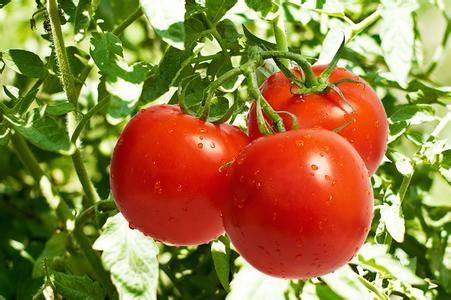The basic planting methods of tomatoes, how to choose varieties and eliminate the problems of planting tomatoes.
Tomato is a vegetable we often eat now, and it is also on the market all the year round. Do you know how to grow it? If you want to know, let's take a look at it.
How to choose tomatoes
Choosing a variety of tomatoes can be confusing, as there are so many, so use our tomato selector to help you choose the garden that works best for you. It is a good idea to grow a range of varieties, including at least one or two disease-resistant types, because of all vegetables, tomatoes tend to be the most susceptible to disease.
Soil, planting and care
Tomatoes run warm; plants in late spring and early summer, except for 10 areas, are autumn and winter crops. In order to start planting, plants start plants instead of seeds. Choose young tomato plants from BonniePlants ®, a company that has spent more than a century helping family gardeners grow the best gardens. Contribute a golden, sunny place to grow tomatoes. Tomatoes need at least six to eight hours of sunlight to bring out the best taste.
You will need to place, grid or cage most tomato plants to get them off the ground. Decide to support the plan before you start planting, and then add support directly after planting.
Give each plant enough space to grow. Space sturdy, long-leaved, uncertain species, ca. 3 feet apart. More orderly plants can be two feet apart. Improve acreage by mixing several inches of high-quality garden soil, such as Miracle-Gro ®PerformanceOrganics ™multi-purpose underground soil rich in compost, as well as the top layer of existing soil. If you are growing in a container, you need at least one 24-inch jar for an uncertain variety, or an 18-inch jar for a certain variety. Be sure to fill containers with high quality potting mixtures, such as Miracle-Gro ®PerformanceOrganics ™container mixtures for best growth results.
When the soil pH value is between 6.2 and 6.8, tomatoes best take in nutrients, and they need a continuous supply of major and secondary phytonutrients. To provide the required nutrients, continuously released fertilizers and calcium (such as Miracle-Gro ®PerformanceOrganics ™multi-purpose plant nutrient particles) are mixed into the soil when preparing the planting hole. The label instructs to continue feeding during the growing season. This will help protect fruit from blossom and fruit rot, a problem that can occur when plants don't get enough calcium.
At the same time, mix 3 to 4 inches of compost, which will provide trace nutrients and help retain moisture and fertilizer in the soil until the plant needs it.
In order to grow really strong tomato plants, we recommend burying 2/3 of the stems when planting. This critical step will cause the plant to sprout along the buried stem, so your plant will be stronger and better able to find water in drought. Please note that this deep planting method applies only to tomatoes (and tomatillos), not to other vegetables.
Immediately after planting, the seedlings helped them settle down.
You can combine fast-ripening varieties with special seasonal stretching techniques to grow early crops, but wait until the final frost to plant main-season tomatoes.
Cover the ground with 2 to 4 inches of mulch to reduce weeds and help keep the soil evenly moist. Straw and chopped leaves make a good mulch for tomatoes
Water regularly, at least an inch of moisture per week (through rain or watering), and more in summer. Feel the soil; if the top inches are dry, it's time to water.
Troubleshooting
With the hot summer, it is difficult for some tomatoes to begin to bear fruit. Please be patient. When the night starts to cool down, you will see the little green tomatoes again. At the same time, harvest ripe tomatoes in time to reduce the heavy burden on stressed plants. If you live in areas where summer temperatures are usually in the 1990s, be sure to choose some heat-resistant tomato varieties because they can bear fruit at high temperatures.
If summer droughts are common in your area, or if you tend to forget to water, use immersion hoses, drip irrigation or other drought measures to help maintain uniform soil moisture. This not only helps prevent broken fruit, but also helps to prevent blossom and fruit rot. Water fluctuations can reduce the amount of calcium that plants can absorb, which can lead to blossom and fruit rot. )
The humid weather creates ideal conditions for fungal diseases such as early blight, which will form black spots on the lower leaves. Be sure to get rid of any unhealthy medical treatment or sick leaves throughout the season. Late blight is a more destructive disease that kills plants quickly; the only way to control it is to prevent it by spraying leaves with approved fungicides such as chlorothalonil or copper and to keep the garden clean of plant debris.
You also want to keep an eye on pests. For example, in the middle of summer, a large green caterpillar called tomato horn earthworm eats tomato leaves, sometimes destroying fruit. One or two horned earthworms can remove leafless plants in a short time! Deal with pests as soon as they are found.
By the end of summer, plants that begin to produce at the beginning of the season will show signs of fatigue. With a little effort, you can extend the life of those sad tomato plants by pruning withered leaves and branches. Then follow up the treatment of liquid plant food and leaf diseases or insects as needed.

- Prev

What are the characteristics of Taiwan red pomelo? how does it taste?
In addition to the famous Wendan, there is also a kind of red Wendan (red grapefruit) with large shape and bright red flesh, which is rich and juicy and sweet, but also has a slightly sour flavor similar to grapefruit. It has become the first choice for many connoisseur diners in the Mid-Autumn Festival.
- Next

Litchi planting technology and management, litchi varieties can be classified in this way how to fertilize and irrigate litchi
Litchi, a kind of fruit, is loved by many people. Do you like eating litchi? Do you want to grow your own litchi? Litchi fruit is large heart-shaped, with smooth spines after maturity, dark red pericarp, sweet and juicy taste, large stone, medium quality, high yield and florescence.
Related
- The first cup of black tea in spring, the flavor and history of tea gardens in Kenya, Africa
- The computer can not only choose potatoes, but also grow tea rice. AI will grow winter oolong tea champion.
- It is not only the inflated tea bitten by insects, but also engraved with the four seasons tea in Beipu.
- The Oriental Beauty Tea Festival in Zhuxian County takes the stage at the weekend to experience the plus-size feast of oil tea.
- & quot; Oriental Beauty Tea & Exploration of Emei in Hsinchu, the hometown of quot;
- The new variety of strawberry "Tainong 1" dessert is the first choice with mellow aroma. Crimson gorgeous
- History of Tea in Taiwan: from Wild Inner Mountain to Export Tea Garden
- Two types of Taiwan Oriental Beauty Black Tea won the British three-Star Award for Childhood Tea Xiang Zhang Jiaqi changed from pilot to champion tea maker.
- Banana species and varieties: the planting history of Taiwan Xianren banana and dwarf banana is long, is banana disease resistant?
- Coffee planting Technology: Qianjie Coffee from Seedling to harvesting

